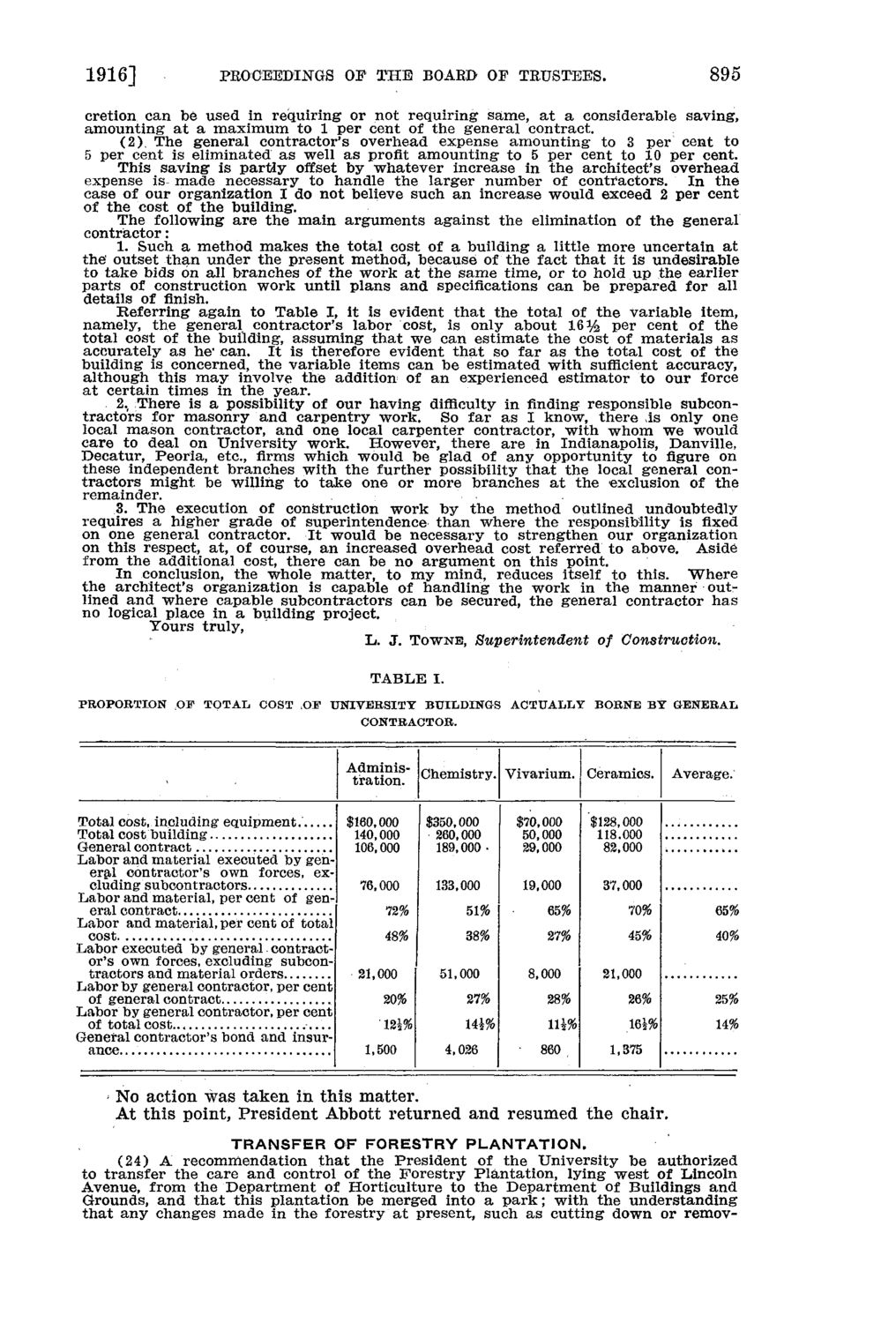| |
| |
Caption: Board of Trustees Minutes - 1916
This is a reduced-resolution page image for fast online browsing.

EXTRACTED TEXT FROM PAGE:
1916] PROCEEDINGS OF THE BOARD OF TRUSTEES. 895 cretion can be used in requiring or not requiring same, at a considerable saving, amounting at a maximum to 1 per cent of the general contract. (2), The general contractor's overhead expense amounting to 3 per cent to 5 per cent is eliminated as well as profit amounting to 5 per cent to 10 per cent. This saving is partly offset by whatever increase in the architect's overhead expense is- made necessary to handle the larger number of contractors. In the case of our organization I do not believe such an increase would exceed 2 per cent of the cost of the building. The following are the main arguments against the elimination of the general contractor: 1. Such a method makes the total cost of a building a little more uncertain at the' outset than under the present method, because of the fact that it is undesirable to take bids on all branches of the work at the same time, or to hold up the earlier parts of construction work until plans and specifications can be prepared for all details of finish. Referring again to Table I, it is evident that the total of the variable item, namely, the general contractor's labor cost, is only about 16% per cent of the total cost of the building, assuming that we can estimate the cost of materials as accurately as he* can. It is therefore evident that so far as the total cost of the building is concerned, the variable items can be estimated with sufficient accuracy, although this may involve the addition of an experienced estimator to our force at certain times in the year. 2. There is a possibility of our having difficulty in finding responsible subcontractors for masonry and carpentry work. So far as I know, there vis only one local mason contractor, and one local carpenter contractor, with whom we would care to deal on University work. However, there are in Indianapolis, Danville, Decatur, Peoria, etc., firms which would be glad of any opportunity to figure on these independent branches with the further possibility that the local general contractors might be willing to take one or more branches a t the exclusion of the remainder. 3. The execution of construction work by the method outlined undoubtedly requires a higher grade of superintendence than where the responsibility is fixed on one general contractor. It would be necessary to strengthen our organization on this respect, at, of course, an increased overhead cost referred to above. Aside from the additional cost, there can be no argument on this point. In conclusion, the whole matter, to my mind, reduces itself to this. Where the architect's organization is capable of handling the work in the manner outlined and where capable subcontractors can be secured, the general contractor has no logical place in a building project. Yours truly, L. J. TOWNE, Superintendent of Construction. TABLE I. PROPORTION OF TOTAL COST .OF UNIVERSITY BUILDINGS ACTUALLY BORNE BY GENERAL CONTRACTOR. Adminis- Chemistry. Vivarium. tration. Total cost, including equipment. $160,000 Total cost building 140,000 General contract 106,000 Labor and material executed by general contractor's own forces, excluding subcontractors 76,000 Labor and material, per cent of general contract 72% Labor and material, per cent of total cost 48% Labor executed by general contractor's own forces, excluding subcontractors and material orders 21,000 Labor by general contractor, per cent of general contract 20% Labor by general contractor, per cent of total cost..« General contractor's bond and insur1,500 ance. $350,000 260,000 189,000133,000 51% 38% 51,000 27% U\% 4,026 $70,000 50,000 29,000 19,000 65% 27% 8,000 28% lli% 860 Ceramics. $128,000 118.000 82,000 37,000 70% 45% 21,000 26% 16i% 1,375 Average. 65% 40% 25% 14% No action was taken in this matter. At this point, President Abbott returned and resumed the chair. TRANSFER OF FORESTRY PLANTATION. (24) A recommendation that the President of the University be authorized to transfer the care and control of the Forestry Plantation, lying west of Lincoln Avenue, from the Department of Horticulture to the Department of Buildings and Grounds, and that this plantation be merged into a park; with the understanding that any changes made in the forestry at present, such as cutting down or remov-
| |